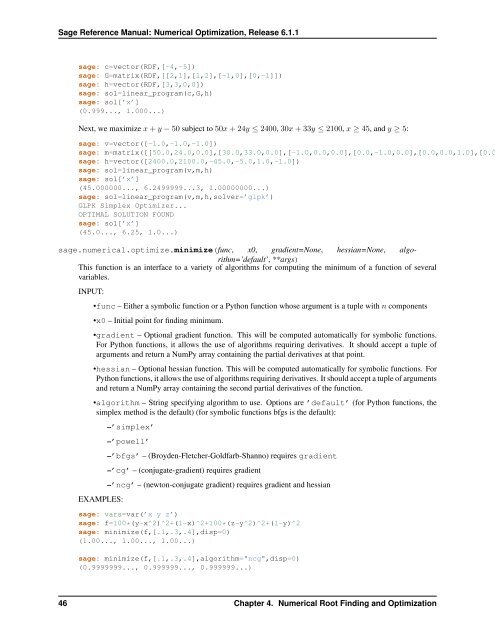Sage Reference Manual: Numerical Optimization - Mirrors
Sage Reference Manual: Numerical Optimization - Mirrors
Sage Reference Manual: Numerical Optimization - Mirrors
Create successful ePaper yourself
Turn your PDF publications into a flip-book with our unique Google optimized e-Paper software.
<strong>Sage</strong> <strong>Reference</strong> <strong>Manual</strong>: <strong>Numerical</strong> <strong>Optimization</strong>, Release 6.1.1<br />
sage: c=vector(RDF,[-4,-5])<br />
sage: G=matrix(RDF,[[2,1],[1,2],[-1,0],[0,-1]])<br />
sage: h=vector(RDF,[3,3,0,0])<br />
sage: sol=linear_program(c,G,h)<br />
sage: sol[’x’]<br />
(0.999..., 1.000...)<br />
Next, we maximize x + y − 50 subject to 50x + 24y ≤ 2400, 30x + 33y ≤ 2100, x ≥ 45, and y ≥ 5:<br />
sage: v=vector([-1.0,-1.0,-1.0])<br />
sage: m=matrix([[50.0,24.0,0.0],[30.0,33.0,0.0],[-1.0,0.0,0.0],[0.0,-1.0,0.0],[0.0,0.0,1.0],[0.0<br />
sage: h=vector([2400.0,2100.0,-45.0,-5.0,1.0,-1.0])<br />
sage: sol=linear_program(v,m,h)<br />
sage: sol[’x’]<br />
(45.000000..., 6.2499999...3, 1.00000000...)<br />
sage: sol=linear_program(v,m,h,solver=’glpk’)<br />
GLPK Simplex Optimizer...<br />
OPTIMAL SOLUTION FOUND<br />
sage: sol[’x’]<br />
(45.0..., 6.25, 1.0...)<br />
sage.numerical.optimize.minimize(func, x0, gradient=None, hessian=None, algorithm=’default’,<br />
**args)<br />
This function is an interface to a variety of algorithms for computing the minimum of a function of several<br />
variables.<br />
INPUT:<br />
•func – Either a symbolic function or a Python function whose argument is a tuple with n components<br />
•x0 – Initial point for finding minimum.<br />
•gradient – Optional gradient function. This will be computed automatically for symbolic functions.<br />
For Python functions, it allows the use of algorithms requiring derivatives. It should accept a tuple of<br />
arguments and return a NumPy array containing the partial derivatives at that point.<br />
•hessian – Optional hessian function. This will be computed automatically for symbolic functions. For<br />
Python functions, it allows the use of algorithms requiring derivatives. It should accept a tuple of arguments<br />
and return a NumPy array containing the second partial derivatives of the function.<br />
•algorithm – String specifying algorithm to use. Options are ’default’ (for Python functions, the<br />
simplex method is the default) (for symbolic functions bfgs is the default):<br />
EXAMPLES:<br />
–’simplex’<br />
–’powell’<br />
–’bfgs’ – (Broyden-Fletcher-Goldfarb-Shanno) requires gradient<br />
–’cg’ – (conjugate-gradient) requires gradient<br />
–’ncg’ – (newton-conjugate gradient) requires gradient and hessian<br />
sage: vars=var(’x y z’)<br />
sage: f=100*(y-x^2)^2+(1-x)^2+100*(z-y^2)^2+(1-y)^2<br />
sage: minimize(f,[.1,.3,.4],disp=0)<br />
(1.00..., 1.00..., 1.00...)<br />
sage: minimize(f,[.1,.3,.4],algorithm="ncg",disp=0)<br />
(0.9999999..., 0.999999..., 0.999999...)<br />
46 Chapter 4. <strong>Numerical</strong> Root Finding and <strong>Optimization</strong>
















